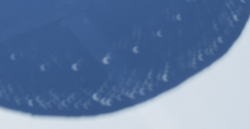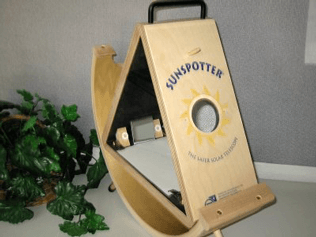
A total solar eclipse is one of the most exciting astronomical events. Some people travel all over the world just to find a few minutes of totality. But the rays of our Sun can damage our eyes if we look at it directly. Indeed, before proper protection was developed, some astronomers in the past lost their vision looking at the Sun. Do not use homemade filters to look at the Sun!
Today we can protect ourselves and still enjoy views of the Sun using proper equipment. Remember that failure to use safety precautions can lead to permanent eye damage or blindness!
On this page: Intro - Indirect Viewing | Eclipse Glasses | Astronomical Equipment | Other Safety Considerations | Eclipse Safety Resources
Indirect Viewing
The best method for observing solar eclipses is the indirect method called, "pinhole projection". By passing sunlight through a tiny opening, an image of the Sun can be focused on a plain background. Do not look directly at the Sun through the pinhole. A pinhole projector like this is also called a pinhole camera.
Make Your Own Pinhole Projector
Take a piece of cardboard or thick paper and punch a small hole near the middle, using a pin or needle. The smaller the hole, the sharper the projected image will be. Standing with your back to the Sun, hold the cardboard with the pinhole above your shoulder, allowing sunlight to pass through the pinhole. Position a second piece of cardboard, or other flat surface, several feet away from the pinhole. The image of the Sun will be projected onto this surface. By adjusting the distance between the pinhole and the flat surface, a clear and focused image of the Sun should appear.
The physics behind the pinhole camera works in nature, too. Trees or bushes that allow tiny slivers of the Sun's rays through their foliage or leaves can also project the image of the Sun on the ground or the wall of a building that is positioned correctly. Other pinhole projectors you may already have on hand include colanders, straw hats or anything with small holes in it. Here is a picture that was taken during the August 21, 2017 solar eclipse. Using a straw hat, the image of the eclipse was projected on the ground.


Eclipse Glasses
Eclipse glasses can be made of hard plastic or paper. Plastic glasses work much like sunglasses, but they are special. If you use these, make sure they are certified safe by the International Organization for Standardization (ISO) or Conformité Européenne (CE). Before using, inspect them for any imperfections. You can never be too careful with solar filters!
Paper eclipse glasses are widely distributed but be careful, make sure that they are ISO and CE certified. Make sure you order them from a well-known source because they can be counterfeited. Inspect them carefully for pinholes. Hold them up in front you, several inches from your face and aim them toward the Sun (without looking directly at the Sun, of course), you can see if sunlight obviously passes through any pinholes. When you wear them, they should produce a comfortable image of the Sun, without any haziness. Never use defective glasses to view the Sun!
* * Find out more from the American Astronomical Society * *
How Can You Tell If Your Eclipse Glasses or Handheld Solar Viewers Are Safe?
Equipment for Safe Eclipse Viewing
Solar filters especially designed for telescopes are available. Glass or Mylar filters may be mounted on the front of a telescope to minimize the light that enters the system. Since the Sun will not require a lot of magnification, some astronomers will use a solar filter with an aperture stop. Do not use filters that work at the eyepiece. It is safe to project the image from a telescope by removing the eyepiece or replacing the eyepiece with a screen. Do this with caution however, because some telescopes use more than one lens and they may be glued together. The extreme heat from the Sun will melt that glue, so be sure your system doesn't rely on an adhesive. Never look through the system without the protection to point the telescope at the Sun! Most astronomers rely on the appearance of the shadow from the telescope to point the system at the Sun.
The best solar filters for telescopes are hydrogen-alpha filters, abbreviated as Hα. These specialized filters are designed to observe the Sun in a specific wavelength of light known as the Hα spectral line. This type of filter is a narrow-band pass filter, that allows only the visible red light of hydrogen to reach the eye. Today H-alpha filters are affordable for amateur astronomers and they are used widely. Each filter allows a specific small range to pass. With this filter there are many features of the Sun that might be seen on the Sun's chromosphere such as thread-like filaments, solar flares, granules, and other features that are associated with sunspot activity. It is also important that you are familiar with your instrument, so test it out before the eclipse. Even if you've observed other solar eclipses, it really pays to work with your equipment ahead of the event.
There are also solar telescopes available. These are fairly expensive, but should be used if serious solar observing is the goal. Celestron sells its products with solar safe filter technology under the brand name, "EclipSmart". The Daystar Solar Scout is a 60mm dedicated solar telescope. The list goes on, but we haven't done an in-depth study of solar telescopes. Perhaps this best left for a future page.

An outstanding solar eclipse observing solution is solar binoculars. These are binoculars that are especially designed to view the Sun. To enjoy solar binoculars fully, they should be mounted on a tripod. Once again, these should be purchased only from a reputable dealer and carefully inspected before each use to ensure that the system has not been damaged. The only thing that can be viewed through solar binoculars is the Sun. If any other light shows up with this system, there is something wrong. Don't use any equipment that you don't have complete faith in. Solar radiation that reaches the Earth's surface includes Ultraviolet and Infrared, as well as Visible light.
Celestron makes three sizes of solar binoculars using Porro prisms, 10x42mm, 12x50 mm, 20x50 mm; and one size of solar binoculars using roof prisms, 10X25mm. The first number refers to the magnification power of the system and the second number refers to the size of the primary objective on the front of the binoculars. There are other manufacturers that make solar binoculars such as Orion or Lunt, but we have no experience with those brands. All the vendors/manufacturers mentioned here also make various solar-safe telescopes.
Figure 1 shows the setup that was used for the October 14, 2023 annular solar eclipse. The binoculars are the Celestron 10x42mm EclipSmart solar binoculars mounted on a sturdy Bogen tripod. This system for observing the 2023 annular eclipse was used to withstand strong winds in Corpus Christi, Texas.
+ + Find out more about binoculars at Astra's.


Other Special Equipment

The Sunspotter should be a great instrument for young children as it uses projection to safely image the Sun. It is a triangle-shaped wooden telescope that sits in a semi-circle cradle. It has as 62-mm diameter objective lens that projects a 3-inch solar image. It will show bright sunspots as they move across the disk of the Sun. The system it uses to create the image is a folded-Keplerian telescope. It has a 12.5-mm plossl eyepiece that cannot be switched out. It uses a simple system to align the instrument to the Sun. The instructions for using it are written right on the body. It works well with groups of people because there is no eyepiece to look through. Images of the solar disk can be taken easily.
The Sunspotter will even work on the Moon when it is so bright in the sky normal telescopic views are too bright.
Other Solar Eclipse Safety Considerations
Don't neglect to protect your skin from the Sun while you are observing that solar eclipse! Yes, the sky will be dark at totality, but it is quite exciting to watch as the Moon crosses the disk of the Sun. If you are using a telescope or other magnification, the disk may be full of interesting sunspots. You may be hanging out in the Sun for several hours to view the whole eclipse. Make sure you have sunscreen, especially for your face and don't forget to use it. A hat will help as long as it doesn't interfere with instruments you will be using.
Wear protective clothing and be sure there is a place that you can rest out of the Sun for a while, if you watch the whole eclipse. Make sure you have access to water and other facilities. Umbrellas and chairs might be among the equipment you choose. If you go to a remote location, you will want to bring along food as well as water and other liquids. Be mindful of possible pests, insects or animals.
Although safety is important for human eyes, don't neglect to protect your equipment. Cellphones and handheld cameras can be damaged by the Sun if they are not protected. Don't let them be exposed to the Sun too long. No exposure without proper protection is the best route to take.
Eclipse Eye Safety - From NASA
This site covers all solar eclipses: total, annular and partial.
How to View a Solar Eclipse Safely - National Park Service
This site covers eclipse safety and may also help you to plan your trip. Many National Parks on the centerline of the 2024 eclipse will hold programs and it might be good to check them out. Additionally, state parks will open their doors for visitors. Be wise and check ahead because you will want tickets ahead of the day of the event.
Solar Eclipse Safety Activity - From NASA Langley
Make a mask using a paper plate and paper solar glasses to protect your face from sunburn while observing the Sun.
How to Make a Pinhole Camera - From NASA Jet Propulsion Laboratory
A student project from JPL to make a pinhole camera that to watch a solar eclipse safely and easily.
Find Out If Your Eclipse Glasses Are Safe - from NASA Goddard, a 1-minute video on testing your solar eclipse glasses.
Make a Projector to Safely See a Solar Eclipse - From timeanddate.com
TimeandDate has instructions for making a pinhole projector to see a solar eclipse. You may also be interested in searching their site for more information about upcoming solar or lunar eclipses. The site can also give you the details on when an eclipse or other events will occur in your own time zone.
Solar Eclipse Across America - American Astronomical Society (AAS)
AAS provides a more complete guide to the April 8, 2024, total solar eclipse. It has been linked here for convenience, but more information about the April 8, 2024 eclipse is also available on this site. It contains more resources for that specific eclipse. On this site educators can find printable handouts for their students


Please feel free to point others to this URL. Images on this page are NOT in the public domain in the U.S.A. The text on this page is copyrighted by the author, ©2024 Dawn Jenkins, and is NOT released into the public domain. It should not be copied to another site without permission or otherwise published without contacting and crediting the author. Seriously, just ask!
Please read the copyright statement linked below. For more information and other permissions use Astra's Contact Page.